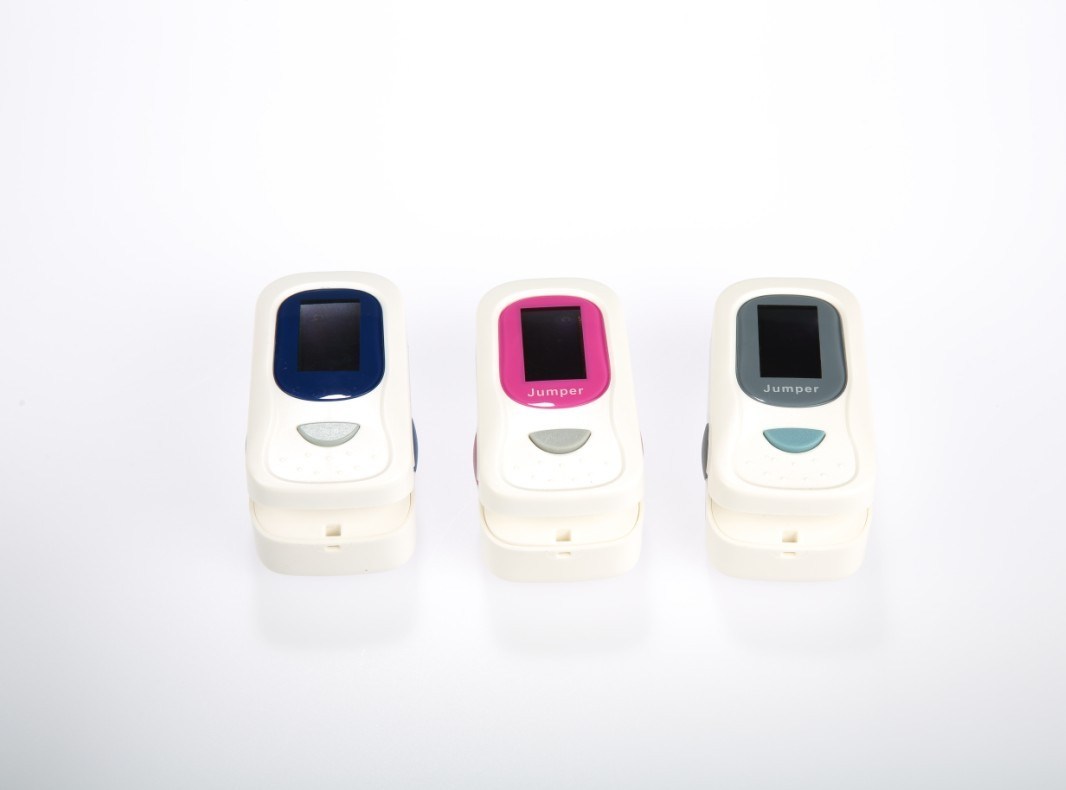CE &FDA certified Finger Pulse Oximeter (JPD-500A)
with pink, blue and grey colors for choosing
Feature:
1. Can be used in hospital, home, community medical treatment, sports healthcare, ect.
2. Can measure SpO2, PR accurately.
3. SpO2 and PR display, PR waveform and bargraph display
4. Battery voltage low indication.
5. Four directions and eight modes
6. Low power consumption; Shut off automatically when no signal
7. Pulse sound function
8. Alarm function
Use Method:
1. Install two AAA batteries into battery compartment correctly.
2. Place damp over finger nail as the following diagram.
3. Insert one finger into rubber hole of the Oximenter fully.
4. Press the switch once on the front panel
5. Finger and body should not tremble during measuring
6. Read correspondent date from display screen
Packing list:
- 1 x Pulse oximeter
- 2 x AAA Alkaline Batteries
- 1 x English user's manual
- 1 x handing rope
Why is pulse oximetry so important?
Once a patient starts losing oxygen, a doctor has less than three minutes to prevent risk of brain damage, heart failure and death.
A healthy body should never fall below 95% oxygen saturation, and oximeters can detect changes as small as 1%. Before oximeters were invented, experienced clinicians would only notice signs of hypoxia (oxygen starvation) when patients became cynaosed - literally their skin began turning blue, with oxygen saturation damagingly low at 85%.
Introduced in 1985, pulse oximeters were rapidly adopted by anaesthesiologists as the universal standard of care in operating theatres, emergency, recovery and neonatal units and all wards (especially in paediatric wards). Oximeters are used in the treatment of pneumonia; they can be used to prevent neonatal blindness - they are a key component of the WHO Safe Surgery Checklist.
In most high-income countries where pulse oximetry is universal across the perioperative process, anaesthesia has become very safe: rates of mortality directly attributable to anaesthesia are typically less than 1 in 50,000 procedures. In low income countries the rate is often at least ten times higher than this, and can be up to 1000 times higher.
Upgraded to the highest level of recommendation in the updated 2010 International Standards for a Safe Practice of anaesthesia, developed and endorsed by the World Federation of Societies of Anaesthesiology, pulse oximetry is essentially mandatory - and dangerously scarce in low-resource countries.
Who need pulse oximeter?
Pulse oximeters are now used routinely in critical care, anaesthesiology, and A&E departments, and are often found in ambulances. They are an increasingly common part of a GP's kit. Pulse oximetry's role in primary care may include:
Diagnosing and managing a severe exacerbation of chronic obstructive pulmonary disease (COPD) in the community.
Grading the severity of an asthma attack. Where oxygen saturations are less than 92% in air, consider the attack potentially life-threatening.
Assessing severity and oxygen requirements for patients with community-acquiredpneumonia.
Assessing severity and determining management in infants with bronchiolitis.
|
Dimension |
62(L)×32(W)×33(H) mm |
|
Weight |
30 g |
|
Accessory |
Lanyard, battery and user manual |
|
Technical Specifications |
|
SpO2 |
|
Measurement Range |
0-100% |
|
Accuracy |
70-100%:±2%
<70% : Unspecified |
|
Resolution |
±1% |
|
Low Perfusion |
<0.4% |
|
Pulse Rate |
|
Measurement Range |
30-250 bpm |
|
Accuracy |
±1 bpm or ±1%, whichever is greater |
|
Pulse Intensity |
Bargraph Indicator |
|
Pulse Rate Alarm Limit |
High:120 bpm, Low: 60 bpm |
|
Power Requirement |
|
Battery |
Two AAA 1.5V Alkaline Batteries |
|
Power Consumption |
Less than 30 mA |
|
Battery Life |
20 hours |
|
Environmental |
|
Operation Temperature |
5-40°C |
|
Storage Temperature |
-10-40°C |
|
Ambient Humidity |
15-80% on operation
10-80% in storage |
|
Air Pressure |
70-106%KPa |
|
Package Info |
|
Unit Specification |
G.W.: 0.1Kgs
N.W.: 0.07Kgs
Size : 83.0 x 77.0 x 50.0mm |
|
Carton Specification |
G.W.: 11.0Kgs
N.W.: 9.0Kgs
Size : 420.0 x 390.0.0 x 280.0 mm (100 pcs/CTN) |
Established in 1998, Jumper Medical is dedicated to designing and manufacturing healthcare products for personal and hospital market. Our vision is to improve the quality of human life by supplying affordable, convenient and reliable healthcare products to more families around the world.
Our products include fetal Doppler, pulse oximeter, infrared thermometer, blood pressure monitor, fetal monitor/CTG machine, patient monitor, vital signs monitor, ECG machine, etc. Our products are ISO13485, CE, FDA proved. In order to make sure every product conforms to RoHS requirements, all raw materials used are compliant with RoHS directives and all products are produced with RoHS compliance awareness.
With 15 years' experience in OEM/ODM service and concentration on healthcare industry, Jumper Medical welcomes professional partners to join us to achieve a better future in healthcare community.
